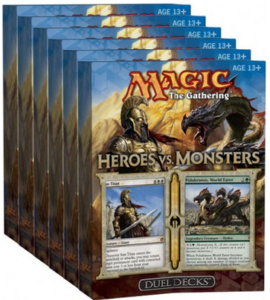It’s my favorite time of year: the weather is cooling off, the baseball playoffs just started, and most importantly the new Limited season has begun with the amazing fall set Theros! Now I know what you are thinking: not another obnoxious Boston Red Sox fan. Fear not! I have no love for the beantown bombers. My team is the Atlanta Braves. Back in April I had a feeling my team was going to have a special year. So far so good, as they won 96 games and the National League East crown. Now that the playoffs have begun, the Braves have their work cut out for them. But enough about baseball. While the Braves are battling the Los Angeles Dodgers this weekend, I’ll be battling a giant field of Limited mages at Grand Prix Oklahoma City. Team Hipsters is rolling four deep this weekend, and I have high hopes for Dave, Hunter, Matt, and me.
GP OKC is our first opportunity to play Theros Limited on the big stage. The field should be full of pros battling before they head to the Emerald Isle for Pro Tour Theros in Dublin. Playing a new format is exciting! You never know what you’ll see at the first Limited GP of the season. But I have a pretty good guess what we’ll see a lot of on day one as we battle nine rounds of sealed: a wall of green monsters.
Theros features one of the eternal battles: heroes against monsters. Heroes are small, cheap creatures that grow in size and strength through the Heroic mechanic. Monsters are big creatures that become ginormous through the Monstrosity mechanic. The set has other things going on as well, but because sealed is a format defined by the random array of creatures you can open in six booster packs, you can be sure that heroes and monsters are going to show up in most decks. And of the two, monsters look to be the creatures of choice in Theros sealed.
Sealed is a format defined by powerful cards. The pool available for building your deck is random. Unlike a draft, where you can pick cards that work together, in sealed you are stuck with what you open. Because of this, individually powerful cards will supply most of the strength in your deck. Synergy cards, which start weak but gain power through favorable interactions with other cards, have a hard time shining in sealed. Unless you happen to open a bunch of cards that share the same synergies, you won’t have much luck playing that sort of strategy.
Heroic is a synergy mechanic. To use Heroic, you have to do two things. First, you have to play a creature with the Heroic ability. Theros has 229 cards (not counting the 20 basic lands). Of those, 19 have Heroic. That is eight percent of the set. Even if all cards were the same rarity, out of the 84 cards in your sealed pool, you’d average 7 Heroic cards. Of course with the various rarities, you can expect less. Only five of the 101 commons in Theros have Heroic. That’s five percent. The ratios at higher rarities increase a bit: 7 of 60 uncommons (12%) and 6 of 68 rares/mythics (9%). Ignoring foils, in your sealed pool you get 60 commons, 18 uncommons, and six rares/mythics. Applying those ratios, you can expect on average 3 common, 2 uncommon, and half a rare/mythic in your sealed pool to have Heroic. That’s not a lot to work with, especially when you add in the constraints of the mana system. But that’s not all you need. Once you have a Heroic creature on the battlefield, you have to cast another spell targeting that creature. I won’t go through the math, but you can see a lot has to go right for you to even have the cards available in your pool to build a deck around the Heroic mechanic. Now, you might open an Anax and Cymede and not care too much about other Heroic creatures, but good luck having enough copies of Wingsteed Rider and Phalanx Leader to fill out the strategy. I wouldn’t hold much hope for Heroic. Or the Creedence.
Monstrosity, by contrast, requires no synergy at all. You play a Nessian Asp on turn five, and then on turn seven you can make your 4/5 into an 8/9. Just like Heroic, there are 19 cards in Theros with the Monstrosity mechanic. Only two are common, Nessian Asp and Ill-Tempered Cyclops. But here’s the difference: all you need to make a monster good in your deck is the mana to cast it. You never have to draw another card besides land to get full value from each one. Plus, there are a lot of other creatures in the set that are big without having the Monstrosity mechanic. Vulpine Goliath looks monstrous to me.
Sealed generally tends to be a slow and grindy format. If you have enough big creatures in your deck, eventually your opponent will run out of ways to deal with them. Green is the color of huge creatures and this format features huge creatures. So I expect most decks to default into playing green. Some pools will assemble enough powerful synergies or bombs in other colors, but pretty much every pool will at least offer the option of jamming a bunch of big green commons and uncommons, with a second color added to fill out the curve with whatever is most powerful in your pool. On top of this, green has the most access to mana fixing, which helps you play as many of your bombs and removal spells as you can. In a green deck, Nylea’s Presence might as well be Prophetic Prism. If you read my last article, you know how much I love that card.
I put my green theory to the test last weekend at the Theros release events at Twenty Sided Store. I played the morning sealed event and sure enough, I played green. Here’s the deck I built:
Hammerin' Hank
Po-Lu-Kra-Nos, something something, Burt Ward? This deck builds itself! Those are some great green cards. I would go through and discuss each, but they are all awesome. See why green is so strong? Everything is good! Karametra’s Acolyte is especially powerful as it ramps into your big threats. The Hydra’s Monstrosity doesn’t look so expensive if you can tap the acolyte for five or seven green mana!
Red was the best color to pair with green, thanks to Hammer of Purphoros, Purphoros’s Emissary, Anger of the Gods, Ill-Tempered Cyclops and Spearpoint Oread. Anger of the Gods is especially good to pair with green, as it leaves more room for the big ones to fight in, you know. Unfortunately I had no red burn spells, but a light black splash gave me Lash of the Whip along with the powerhouse draw spell Read the Bones and super value creature Pharika’s Mender. I had plenty of mana fixing available and probably could have worked in the Griptide if I had tried harder, but I was feeling restrained that day. I chose to leave Opaline Unicorn out of the main deck but that was probably wrong even if it can’t withstand the gods’ anger.
18 lands seems to be the norm in Theros sealed, but I felt fine with 17 thanks to the Acolyte and another all-star, Burnished Hart. Cantripping off Nylea’s Presence also helps dig for lands. I think this might be true of many decks given the variety of non-land mana sources in the set. Burnished Hart, Traveler’s Amulet, and (theoretically) Ordeal of Nylea dig lands out of your deck. Voyaging Satyr, Opaline Unicorn, and Karametra’s Acolyte produce mana themselves. Plus, you can run a few of the cantrip enchantments if they fit your deck and effectively cycle into your lands.
The Games
Round one I was matched up with Alex Ullman. I knew Alex only through his blog and writing for StarCity Games, so it was great to finally meet for a battle. And what a battle it was! He wrote about it here. Alex was, sure enough, also playing green. His green black deck was quite good. I like black as the best color to pair with green because it proides strong removal and multiple ways to buy back creatures from your yard. Alex had both Pharika’s Mender and March of the Returned, plus double Read the Bones. He also had three deathtouch creatures to help stave off my monsters.
Game one we both were stuck on mana early and had to discard. I eventually drew a Burnished Hart to find more lands and play out some big creatures. That was enough to beat down for the win. Game two I was progressing well with the beatdown plan. I was ahead on the race, 12 life to 8, and Alex was looking to have to start chump blocking to stay alive. But he dropped Mogis’s Marauder, made his team unblockable, and swung for exactsies.
Going into game three, I boarded out my Fade Into Antiquity because I had not seen a single target. So it figures in game three he bestows a Nighthowler on a Returned Centaur. I was still able to race. On the deciding turn, I untapped with 7 life to his 9. My board was a Nessian Courser and a 3/3 Centaur Battlemaster. His four-power Centaur was tapped, and he had only a freshly-summoned Blood-Toll Harpy back on defense. I had two bestow cards in hand, Nylea’s Emissary and Spearpoint Oread. He had cards in hand and mana open, so I figured he had some sort of removal. That led me to want to attack with a giant Battlemaster and hold back the Courser to block his Nighthowled centaur zombie. I bestowed Nylea’s Emissary on the Battlemaster, making it a lethal 9/9 trampler. This way, he has to either spend his removal to stop my Battlemaster (which probably leaves the Emissary on board for further combat) or he has to chump with his Harpy and go to one life. Getting the Harpy off the board turns his two-power flying attacker into +1/+1 for the Nighthowled creature, which was enough for me to survive a crack back even if he removed my blocker, as he could only get to six power. That seemed safe, so I swung in for 9. He actually had a brilliant play: Pharika’s Cure targeting my Nessian Courser, which did not kill my creature but did gain Alex two life. That allowed him to take all nine from my attack and save his Harpy. Then he untapped, played his actual removal spell to kill my centaur, raise his on-board power to seven, and swing for lethal. I was sad to lose, but what a great match!
Round two I faced John Powell piloting a green red deck in a pseudo-mirror. His was more aggressive than mine, but the decks had similar gameplans. Game one, I got very devoted to Green, then played Karametra’s Acolyte into Polukranos, World Eater. Thanks to all my extra green mana from devotion, I was able to Monstrify Pulokranos for X=2 the turn I played it, killing a Firedrinker Satyr and a Satyr Piper. That game ended soon after. Game two John got off to a faster start and got me down to seven life while he dealt with my early plays with Time to Feed, gaining life in the process. It was his 20 life to my 7, but I was able to attack into his Sedge Scorpion with a 3/3, trade them off, then drop Polukranos and eat his other two creatures post-combat. That swung the game and I won soon after. Go figure, a 5/5 for four mana that also eats some creatures for a bit more mana is a game-breaking card.
Round three I once again squared off against a green black deck, this time piloted by Anthony Verdin. Game one went like this: he played out three small creatures and attacked. I played a Leafcrown Dryad, traded it off, then ramped from Burnished Hart on turn three into seven mana on turn five. My fifth turn I cast Anger of the Gods, wiping the three creatures from his board, then used my remaining four mana to cast Nemesis of Mortals, thanks to the Dryad and Hart that went to my graveyard prior to my exile sweeper. That was all she wrote. Game two, he got me to use my only enchantment removal spell on Erebos’s Emissary, then played Whip of Erebos and took over the game. I put up a good fight, but I had unfortunately scryed Anger of the Gods to the bottom in the early game when I had the board presence. He was at 30 life when I finally succumbed to his recursive assault. Fortunately for me, he stumbled on lands game three. I dropped a turn four Purphoros’s Emissary, beat down, bestowed it into a really big beater, and won in a few more turns. It’s hard to come up with two blockers when you have no mana.
Sure enough, in round four I played another green deck. That’s a clean sweep for all five decks I saw in the tournament, including mine and my opponents’. This time I played Dustin Williamson who had a strong aggressive green red deck. He’s also a lawyer, so we briefly commiserated on the less glorious aspects of our jobs before he proceded to crush me in two games where I dealt a total of eight damage to him. He had the Lightning Strikes I was missing, and instead of drawing my five mana toughness creatures or Anger of the Gods, I drew Emissaries. I had to play them out and watch them get smote by heavenly lightning. Dustin had strong draws with a good distribution of small creatures, tricks, and removal. He applied enough pressure that I could not play around tricks, and thus I ended up 2-2 in matches on the day. I tried boarding in the Satyr Ramblers to have more early defense, but it was not to be.
Overall, I was pleased with how the tournament went. My deck could have gone 4-0 with a little more luck or skill, and I’m happy to have learned a lot about the format as I head off to Oklahoma City this weekend. This sealed event, plus the practice session that Matt wrote about, were very educational.
Carrie O’Hara is Editor-in-Chief of Hipsters of the Coast.




